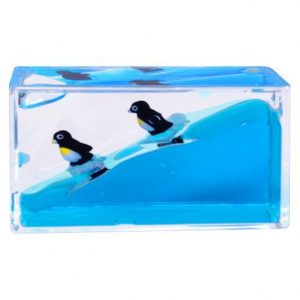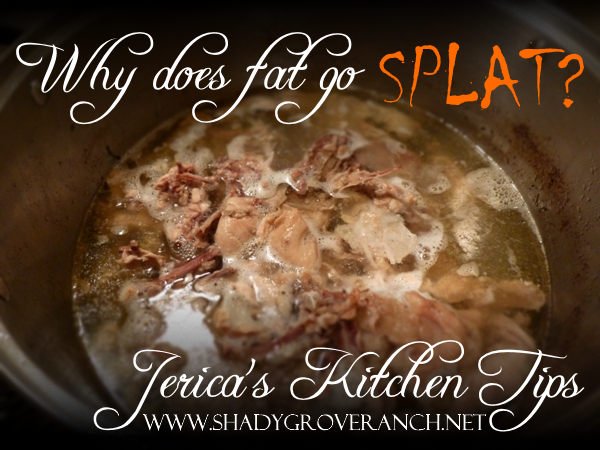I was just chatting with someone about whether or not one could “harvest” the fat that floats to the top of broth while it’s cooking, and use it just like lard. I told her you could, but that it’s not as straightforward to use as regular old rendered lard, that it might tend to explode if heated for frying, and I thought this might be a great topic to share here.
The question was, Can I harvest the fat that rises to the top of my pot during broth-making?
Interesting factoid–if you do this with chicken, the official name of the fat is Schmaltz. Of course, the term “schmaltz” refers to wet-rendered or dry-rendered fat, as long as it comes from poultry. Lard is the oil rendered from pork fat. Tallow is the oil rendered from beef fat.
Dry- vs. Wet-Rendering of Fat
But today we’re going to talk about any kind of fat that rises to the top of a pot of broth. Let’s call it “wet-rendered” fat. The distinction is to separate it from “dry rendered” fat, in which you put chopped or ground raw fat into a dry pot, maybe add just a smidge of water to keep the tissues from scorching while the first of the oil renders out, but then after that, for all intents and purposes, you basically have a pot full of oil with no appreciable water-based liquid in there. When people talk about “rendering lard,” they are talking about the dry-rendering process.
Is it a good idea to do Wet-Rendering?
So the answer to the question of whether you can harvest the layer of fat on top of broth… is yes! You can keep and use the fat that rises while broth-ing. But fat skimmed from the top of broth is going to tend to have a high residual moisture content.
That means when you try to fry something with it, it’s going to tend to splatter a lot!
Why?
Because the boiling temperature of water (212F) is much lower than the typical frying temperature of oil (ballpark of 350F to 400F depending on what you’re doing). If you try to heat the water-laden oil quickly, the water will effectively superheat and create volatile pockets of steam. When they try to rise out of the viscous oil… POP! Lots of little (and sometimes big!) explosions!! And burns, messes, and frustration can follow!
What can you do to safely salvage “wet-rendered” fat?
Here are a couple of ideas:
Method 1: Chill the broth first.
If you thoroughly chill the broth with fat still on top, you will be able to peel/scrape the hardened fat from the top of the broth, which will have gelled at the bottom of the container. The more saturated the fat (as with beef fat), and the colder you chill it, the harder the fat layer will be. With beef fat, you will actually be able to “chip” away the fat, whereas with pork and chicken fat, the fat layer will be softer, like slightly softened butter. Either way, the separation between broth and fat will be VERY distinct.
Cons: Unless you’re REALLY careful, there will still be some residual moisture (aka broth) sticking to the fat, and you may still have issues with splattering. Another negative to this method is that broth actually keeps better with the fat layer intact. If you disturb it in order to harvest the fat for other uses, you’ll need to use or freeze the broth right away, as it will spoil within a couple of days otherwise.
Method 2: Triple-skim the fat/broth.
This is going to be a very labor- and dirty-dish intensive method, but it will yield a very low-moisture oil if you do a good job.
How to do it: When your broth is done cooking, turn off the heat and let it sit, covered, for a while so the oil layer settles into place with no broth bubbling up through it. Use a ladle to skim as much of the oil layer as you can get at without bringing over too much liquid.
Remember those little paperweight toys with the two layers of liquid that never mix?

That’s the idea. You want only the oil to come through when you’re skimming! Repeat this process a couple more times until you’re satisfied that there is no broth left below the oil. Narrower containers will make this easier, as they will make the oil layer deeper and easier to skim near the top. Another thing to keep in mind is that for this method to work, the oil has to still be liquid, meaning the whole concoction must be a little warmer than solidying temperature, which is usually around 78-100 degrees for animal fats, somewhere in there. If it’s a really cold day, you may have to rewarm the broth a little for this to work.
Method 3: Low-temp boil the water out.
A sure-fire way to get every last bit of water out is to bring the oil up to water-boiling temperature (212F) and gently boil the water away. This method definitely has some downsides: It is time-consuming, and it’s the most dangerous method for the reasons I explained at the very beginning. If you try to do this at too high a temperature, you’ll run into the splattering issue. Also, if you’re not close by when the water finally evaporates, the oil will begin to heat rapidly and may start to smoke if unattended. You’ll also have to adjust the heat until you find that sweet spot that makes the water boil, but doesn’t cause splattering. I do use this method, especially if I am going to fry chicken using that very oil, but I don’t go far from the stove while I’m doing it. When I hear the boiling water slow down, I know I’m just about done.
My advice?
Unless there’s just a huge amount of oil atop your broth, leave it! Fat in soup adds flavor and filling characteristics, plus nutrients. And it extends the shelf life of broth significantly. Lots of modern cookbooks say “skim the fat and discard it!” But I just haven’t seen any compelling reasons to do that with pasture-raised meats. Instead, if you want cooking fat, save the drippings from bacon and sausage, or render raw fat (beef or pork) using the “dry” method.
It seems the 13-year mark of small business is when all your equipment decides to break down, especially if most of it was already almost a decade old when you started (but of course we didn’t own much “new” stuff. We like our equipment already “broken in,” ha!). We’ve had to do a boat-load of repairs this year. Matt says we can start calling him Jack, as in Jack of… ... Continue reading | 2 Comments




THANK YOU FOR THIS TIP !! IT WAS SUPER HELPFUL.
This was really interesting, Jerica. It explains a lot.
Great info, Jerica!
One time I used the skimmed fat in a savory pie crust to make spinach chicken alfreddo hand pies for my lunches. It did have a stronger “chickeny” flavor and it was a tad more oily than butter or lard would have been, but it worked fine and sidestepped the splatter issue because I wasn’t heating on the stove, but mixed with flour and baked instead.